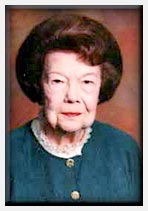The Story of Henry and Jenny Ledrick |
|
 Eloise Lane
Eloise Lane
(In 1886, the Lard, Ledrick and Walstad families were among the first anglos to settle in Roberts County, Texas. The Lards and Ledricks settled on Chicken Creek. The Walstads lived first on Wolf Creek and the flats in Ochiltree County before coming to Roberts County. Museum Mementos ~t 196 tells of the family of William Thomas and Katherine Lard.) Henry Ledrick, born in 1842 in France, became a post-trader in Kansas. He married Amanda Jane "Jenny~ Lard, a daughter of W. T. and Katherine Lard. Henry and Jenny Ledrick were the parents of Henry Lee, Jr. and Paul Claude before they came to Texas. Henry lost all of his property in Kansas as the result of Indian raids. Later the government compensated him for his losses. Henry and Jenny settled on about 13,000 acres in mid-Roberts County. The Ledricks came to Chicken Creek as the ranchers in the area were trying to recover from "the big die-up," the severely harsh winter of 1885-86 when many cattle and other creatures froze to death. The Bar CC Ranch that counted 10,000 head of cattle in the fall had only 700 in the spring. The "big blizzard" came on the nights of January seventh and eighth in 1886 while temperatures dropped to twenty-two degrees below zero and the wind was blowing sixty-five miles an hour. The Southern Kansas Railroad that was constructing the Kiowa Extension of the Santa Fe from Kiowa, Kansas to Panhandle City, Texas~ had paused on the north side of the Canadian River while a bridge was built across the river. The towns of Miami and Pampa were not yet founded, so Henry had to go to Canadian for supplies. On return trips it was possible to see that the entire valley of Chicken Creek was covered with Indian tepees. The Indians were not unfriendly, and Henry was skillful in dealing with them. Like most of the early pioneers, the Ledricks lived at first in a dugout. After several years they built a house of lumber made from logs of native cottonwood trees. The lumber was made at a sawmill on neighboring Indian Creek. The Ledrick ranch house became a stopover for families in covered wagons heading for the West and California. A child of one of the traveling families died and was buried on the ranch in a grave that was well tended for many years. "Aunt Jenny" often acted as a midwife and traveled across the Canadian River on horseback to attend to Olive (King) Dixon, wife of Billy Dixon,~
The railroad station that received its third name as Pampa in 1892 was at first known mainly as a shipping point for cattle. Doubtless cattle from the Ledrick ranch were among the many that came over what is now Cuyler Street on their way to the stockyards. Following the death of Henry Ledrick in 1905, his sons, Lee and Claude, took charge of the ranch. Jenny Ledrick died in Pampa in 1918. Lee Ledrick married Carrie Walstad, and their children were Cassie Balthrope, Vera Shriver, H. L. Ledrick and Paul (Mickey) Ledrick. Claude Ledrick married Fannie May White whose family were pioneers in northern Roberts County. They had no children.
The railroad station that received its third name as Pampa in 1892 was at first known mainly as a shipping point for cattle. Doubtless cattle from the Ledrick ranch were among the many that came over what is now Cuyler Street on their way to the stockyards. Following the death of Henry Ledrick in 1905, his sons, Lee and Claude, took charge of the ranch. Jenny Ledrick died in Pampa in 1918. Lee Ledrick married Carrie Walstad, and their children were Cassie Balthrope, Vera Shriver, H. L. Ledrick and Paul (Mickey) Ledrick. Claude Ledrick married Fannie May White whose family were pioneers in northern Roberts County. They had no children.

